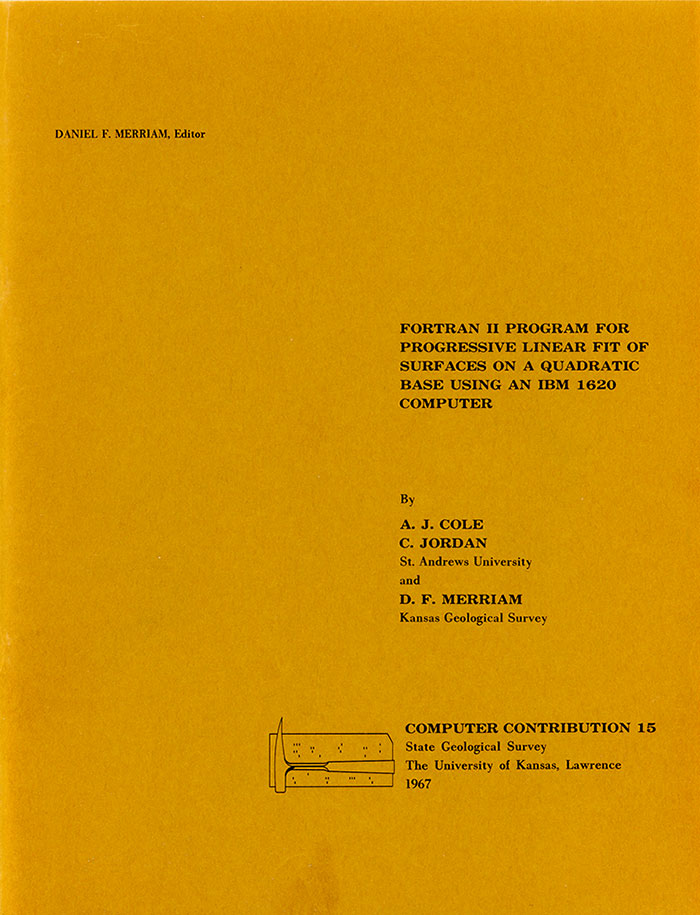
Kansas Geological Survey, Computer Contributions 15, originally published in 1967
1St. Andrews University and 2Kansas Geological Survey

Originally published in 1967 as Kansas Geological Survey Computer Contributions 15.
Geologists are interested in graphic displays of information, especially maps. In recent years, surface-fitting techniques and automated contouring routines utilizing computers have been developed. Different methods have been found advantageous for different problems. This paper reports an application of surface fitting and contouring of structural data in areas of low regional dip. The technique and variations of it have been applied to data from the Midcontinent of the United States and Midland Valley of Scotland.
The technique essentially involves the fitting of a low-degree polynomial (a quadratic or second-degree surface) to the original, irregularly spaced data to establish a rectangular grid. The grid values are then smoothed by fitting a linear (first-degree surface) on a quadrant-by-quadrant basis moving progressively over the grid. Results indicate that surface configuration determined by this method closely approximates the hand-contoured configuration.
In essence, the true surface is approximated by a smoothed surface having high autocorrelation. That is, values at one point are strongly influenced by adjacent points. Geologic discontinuities will be emphasized in the residuals. The method differs from polynomial trend analysis in that the surface is more flexible (residuals will be smaller) and a point is dependent only on adjacent points (up to one-half length or height of the sliding field array) rather than upon all points as is the case in polynomial or Fourier analysis. Thus, major residuals should disappear or be greatly reduced.
Many methods of surface fitting have been investigated. Most studies have been concerned with three-dimensional trend-surface analysis and the separation of regional from local effects. Geologists seek trends and have readily adapted computer-oriented techniques to aid in solving their particular problems (Merriam, 1965, 1966, 1967). Numerous published applications of trend analysis to geologic problems attest to its importance and effectiveness (for example see, Allen and Krumbein, 1962; Duff and Walton, 1964; Harbaugh, 1964; Krumbein, 1959, 1966; Merriam, 1964; Merriam and Harbaugh, 1963, 1964; Merriam and Lippert, 1964, 1966; Merriam and Sneath, 1966; Peikert, 1965; Read and Merriam, 1965; Smith and Harbaugh, 1966; Whitten, 1959, 1961, 1963a, 1963b).
Automatic contouring of data is important for two reasons. First, the methods involved are relatively objective, and second, results are repeatable. The contouring procedure in this program uses linear interpolation between data values. Other routines are available and descriptions may be found in Ojakangas and Basham (1964), Batcha and Reese (1964), IBM (1965), Slack and others (1963), and Tobler (1965).
We thank J. C. Davis and P. F. Smith, Kansas Geological Survey; T. V. Loudon, Sedimentology Research Laboratory at the University of Reading; W.C. Krumbein, Northwestern University; and P.H.A. Sneath, MRC Unit at The University, Leicester, for help in formulating ideas and for reviewing the manuscript. Machine time was made available through the Computing Laboratory at The University, Leicester (England) and the University of St. Andrews (Scotland).
Read the PDF version (5.8 MB)
Kansas Geological Survey
Placed on web Sept. 3, 2019; originally published 1967.
Comments to webadmin@kgs.ku.edu
The URL for this page is http://www.kgs.ku.edu/Publications/Bulletins/CC/15/index.html